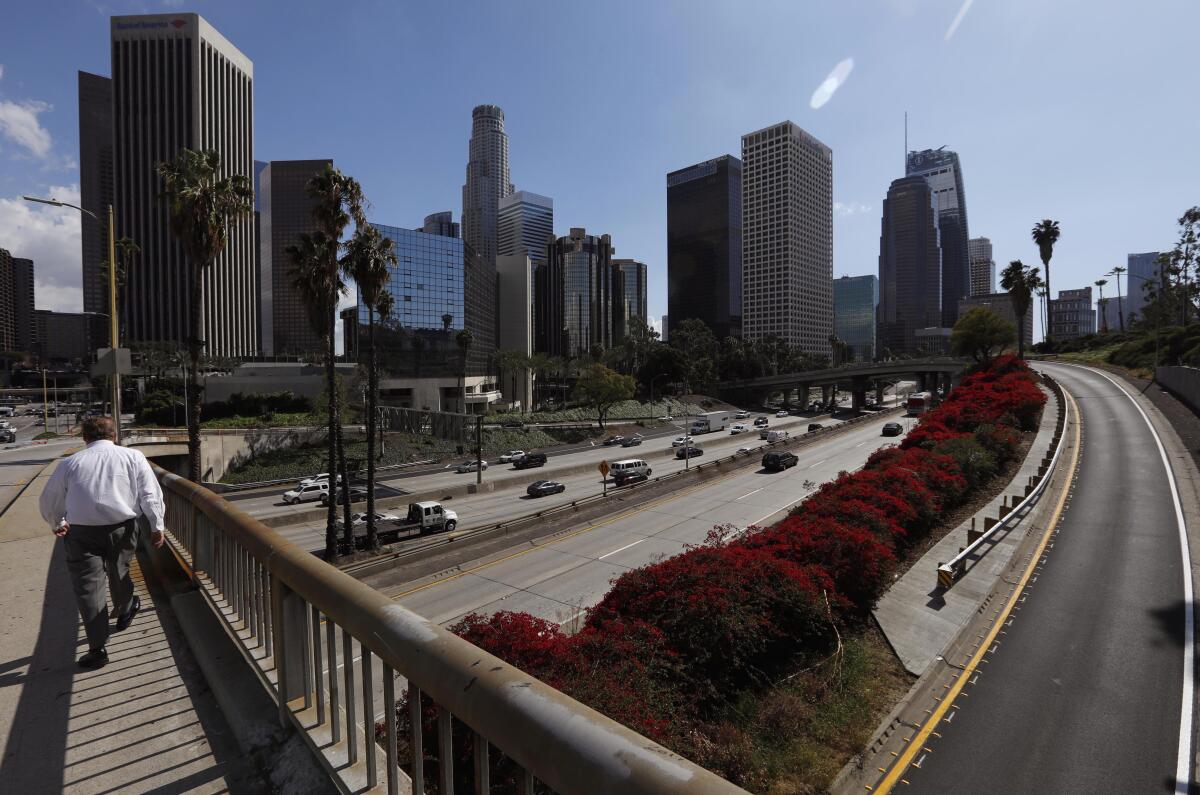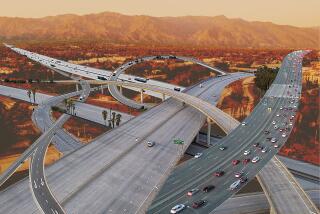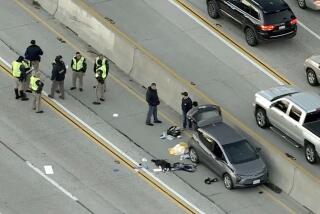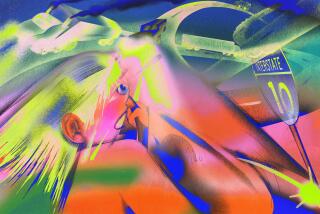Eerily empty freeways: A symbol of how the coronavirus has hurt Los Angeles

Evening traffic on the 405 Freeway in West Los Angeles was so sparse last week that 24-year-old Jerrold Smith II took out his iPhone and recorded it for posterity.
“Just so no one thinks I’m crazy, it’s 6 o’clock,” Smith said, wonder in his voice, as he drove south toward the 10 Freeway. Normally one of America’s worst bottlenecks, the interchange had barely a dozen cars nearby.
As coronavirus fears have swept Southern California, and reported cases of COVID-19 have surged in Los Angeles County, commuters still going to work have encountered a strangely unsettling phenomenon: a lack of traffic jams.
Free-flowing traffic seems more a cause for mourning than celebration as the region grapples with the pandemic. The dream of traffic getting better, Los Angeles commuters say, didn’t include a scenario like this.
“At first I loved it,” said Andrea Martín, 54, as she filled up her Toyota at a Chevron in Historic Filipinotown before driving to the Westside. “Then I realized: ‘Oh, this means people aren’t working.’”
A slightly faster drive to Westchester, she said, is now a painful reminder that many are facing financial uncertainty.
“I feel lucky to still be working,” she said. “My brother works on a TV set and production shut down. My neighbors are terrified they’re going to lose their jobs. Everyone is scared.”
Though maddening, L.A.’s habitually clogged freeways are indicators of low unemployment and a booming economy. Vacant onramps and zippy drives on the 405, by contrast, are signs that the pandemic is taking its toll.
Some workers without paid sick leave are forgoing paychecks. Shift workers and gig workers are seeing their hours cut back. Delivery drivers, film crews and truckers are losing their jobs.
Those changes are reflected in traffic data: Average driving speeds on Wednesday evening were about 27% faster than the typical week, according to data analyzed for The Times by INRIX, a traffic data company based in Washington state. Speeds were up 11% on Thursday morning, and 18% in the evening.
Other cities saw even more dramatic results: On Thursday night in Washington, D.C., speeds were up 31%; in San Francisco, 30%; in Chicago, 25%.
The company calculates the figures by collecting movement data from hundreds of millions of cell phones, in-car navigation systems and delivery fleets. The information is anonymous, without start points or end points, the company said.
The number of hours that drivers were stuck in traffic on Los Angeles-area freeways fell by about 100,000 on Tuesday and Wednesday compared with the prior week, according to California Department of Transportation data collected by sensors embedded in the freeway pavement. Delays fell slightly less on Thursday, the heaviest traffic day of the week, with a decline of about 50,000 hours.
Thousands of Los Angeles employees who would otherwise be heading to work are staying at home. That includes workers at Twitter’s Santa Monica office, Google locations in Playa Vista and Venice, and some at WarnerMedia, NBCUniversal, Sony and Netflix.
The virus has forced the closure of Hollywood writers rooms, film and television production sets. Major talent agencies, including ICM Partners and United Talent Agency, have asked their employees to work from home.
Commuting to major universities has plummeted after UCLA, USC, Cal States Long Beach and Northridge, and Pepperdine announced a move to online-only classes. Each campus is a major employer and a traffic magnet. During a typical week, UCLA alone sees more than 100,000 car trips per day.
With Chinese factories operating at about 40% capacity, cargo volumes have plunged at the twin ports of Los Angeles and Long Beach. Drivers who usually shuttle imported goods to Inland Empire warehouses and downtown rail yards have lost their jobs or seen their hours scaled back.
That drop in truck traffic, a financial disaster for workers, has left the normally traffic-choked South 710 Freeway, 210 Freeway and other major cargo routes far quieter.
“The 210 is just generally insane,” said Josiah Solis, 28, a graduate student and adjunct professor who drives between Thousand Oaks, Pasadena and Claremont multiple times per week. “It’s almost bumper-to-bumper the entire commute any time after 3.”
On Tuesday, he said, he “didn’t hit stop-and-go at all,” even though it was raining. The true mark of his short commute, he said, was that he pulled into his parking spot in Claremont before his podcast ended.
Smoothing out traffic jams and speeding up drive times requires removing far fewer cars than many drivers might expect. Experts estimate that reducing the volume of vehicles on the road by less than 10% can make the difference between brake lights and free-flowing traffic, they say.
That’s because traffic moves relatively smoothly on freeways as long as the number of cars is below the capacity of the lane: usually, between 2,000 and 2,400 vehicles per lane per hour.
When the volume rises above that, and the lanes hit their capacity, traffic grinds to a halt. So a smoother flow of traffic can be achieved as long as volumes stay below capacity — usually, a difference of less than 10% of the cars on the road, experts say.
“Pretty much every freeway lane in L.A. experiences some degree of this phenomenon: everything is going fine, then suddenly, it all slows down,” said Juan Matute, the deputy director of UCLA’s Institute of Transportation Studies.
Local transportation officials put that into practice last year when they estimated that reducing the cars in the 110 ExpressLanes by 5% could shave travel times in half during the peak of rush hour.
More to Read
Sign up for Essential California
The most important California stories and recommendations in your inbox every morning.
You may occasionally receive promotional content from the Los Angeles Times.










